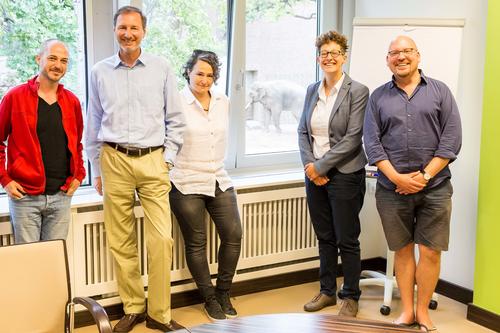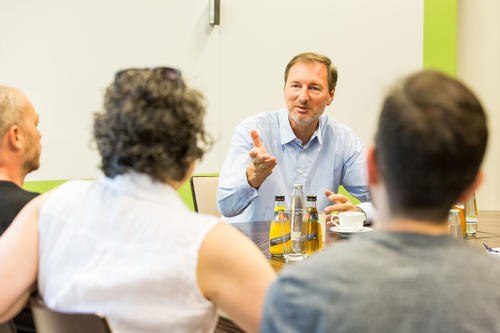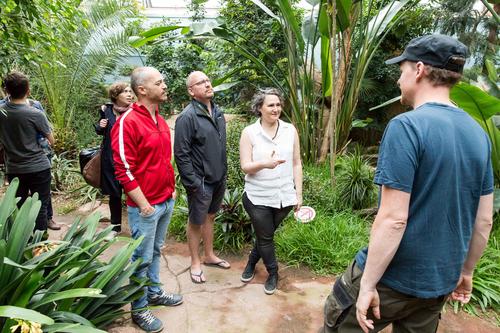An Encounter with a Water Buffalo
Through the Ludwig Armbruster Fellowship, the Berlin Zoo supports doctoral candidates from the Hebrew University of Jerusalem for a stay at Freie Universität – a visit to the zoo is also part of the program.
Oct 10, 2018
Fellow Tuvia Singer meets a young water buffalo on the zoo tour, which is part of the Armbruster Fellowship supported by the Berlin Zoo enabling doctoral candidates from the Hebrew University to spend time doing research in Dahlem.
Image Credit: Frederic Schweizer
Israeli fellows Tuvia Singer (left) and Hilla Lavie (3rd from left) with zoo director Andreas Knieriem (2nd from left), historian Clemens Maier-Wolthausen (right), and Judith Winkler of the CIC. In the background is Victor the elephant.
Image Credit: Frederic Schweizer
“The Berlin Zoo has always been at the heart of society – both good and bad,” zoo director Knieriem explains to the guests. By providing funding for the fellowship, the zoo is living up to its social responsibility.
Image Credit: Frederic Schweizer
At the recently renovated “World of Birds” exhibit, a special glass roof simulates a natural living environment for the birds that live there, curator Tobias Rahde (right) explains to the fellowship recipients.
Image Credit: Frederic Schweizer
There aren’t many meeting rooms from which you can observe an elephant. The meeting room in the administration building of the Berlin Zoo is right next to the elephant enclosure, so Hilla Lavie and Tuvia Singer were able to watch bull elephant Victor, born at Israel’s Ramat Gan zoo in 1993, through the window as he slowly moved around the enclosure while they were meeting with zoo director Andreas Knieriem, who holds a doctorate in veterinary medicine.
There aren’t many meeting rooms from which you can observe an elephant. The meeting room in the administration building of the Berlin Zoo is right next to the elephant enclosure, so Hilla Lavie and Tuvia Singer were able to watch bull elephant Victor, born at Israel’s Ramat Gan zoo in 1993, through the window as he slowly moved around the enclosure while they were meeting with zoo director Andreas Knieriem, who holds a doctorate in veterinary medicine.
Lavie and Singer are two of a current total of four Armbruster Fellows at Freie Universität Berlin who are receiving a fellowship through the Berlin Zoo. The program supports doctoral candidates from the Hebrew University of Jerusalem who want to conduct part of their research at Freie Universität Berlin. Candidates from the disciplines of veterinary medicine, biology, ethics, or history can spend three to twelve months conducting their research in Berlin, and – another special feature – a visit to the zoo is also part of the program.
The fellowship program was established in 2015, the 50th anniversary year of the establishment of diplomatic relations between Germany and Israel. It is named for biologist and bee researcher Ludwig Armbruster (1886–1973), who taught at Berlin’s Friedrich-Wilhelms-Universität until he was expelled in 1934 for refusing to cooperate with the Nazis. Armbruster also maintained ties with Jewish scholars and scientists in Germany and in what was then the British Mandate of Palestine. He was only rehabilitated in 2007.
To date, nine doctoral candidates have participated in the program, which is one of various cooperation formats that exist as part of the strategic partnership between Freie Universität and the Hebrew University of Jerusalem. “The joint promotion of young researchers is a key element of our cooperation,” explains Judith Winkler, who is responsible for coordinating the partnership within the Center for International Cooperation (CIC) at Freie Universität and accompanies the fellows on their tour of the zoo. “The zoo’s support allows doctoral candidates from the Hebrew University to do research here and forge ties with researchers at Freie Universität.”
Zoo director Andreas Knieriem explains that providing funding for the fellowship is one way the zoo is living up to its social responsibility. “The Berlin Zoo has always been at the heart of society – both good and bad.” For example, the zoo’s management at the time adapted unconditionally to the new Nazi regime, and Jewish members were forced out of the board of directors of the Zoo AG by 1936. In some cases, the zoo as an intermediary also benefitted from the forced sale of shares held by Jewish shareholders.
Lavie and Singer find it especially interesting to get to know this additional aspect of a Berlin institution which is usually visited for its animals. Singer says he did not truly realize how important the zoo is in and to Berlin’s history until now. Both candidates are pursuing their PhD in history. Singer is studying projections and historical concepts of the foreign in folk narratives of the 19th century, such as those told by the Brothers Grimm, Ludwig Bechstein, and Heinrich Pröhle. Lavie studies the image of Israel presented in post-war West German films.
Each of them is spending one year doing research at Freie Universität. Singer came to Berlin with his wife and two children, he explains during the zoo tour with curator Tobias Rahde, which also includes feeding water buffalo and seals. He is attending a colloquium held by his advisor Uwe Puschner, a professor of modern and contemporary history at Freie Universität. He says he finds the differences in the academic discipline of history in Germany and Israel particularly fascinating: “We can deferentially learn from each other. I appreciate the emphasis on methodology and the systematic and thorough way of conducting research at the history department of Freie Universität. My experience at the Hebrew University is slightly different: the intention to write history as a story.”
Hilla Lavie is using her time in Berlin at the History Didactics division headed by Professor Martin Lücke to do research on films and TV movies in archives such as the Deutsche Kinemathek and the German Federal Archives. She has already found a number of works that have hardly been discussed so far – or not at all – in research on her topic. Her dissertation deals with postwar relations between Israel and Germany, especially the depiction of Israel in West German films between the 1950s and the 1970s.
Tobias Rahde, who holds a doctorate in biology, showcases the zoo’s current approach to creating animal habitats at the newly renovated “World of Birds” exhibit. A glass roof that looks like a normal window to visitors filters the UV light in a way that birds perceive it to look like a canopy of leaves, Rahde explains. While the animals in the zoo used to be presented for humans, the focus now is on making their enclosures as livable as possible for them. A great deal has changed in terms of how animals are kept over the zoo’s 170-year history. Or, as zoo director Knieriem put it earlier, “Today animals are ambassadors of their endangered environments. Our goal is to draw visitors’ attention to these threats to our environment as well.”
The tour concludes with a visit to the historical exhibit in the Antelope House together with the curator Clemens Maier-Wolthausen, who holds a doctorate in history. In the exhibit guests can trace the zoo’s development, from its early days as a royal menagerie on Pfaueninsel at the beginning of the 19th century, when it was located on an island in the outskirts of town to the present day.
Hilla Lavie says she finds the contributions made by Jewish Berliners to the zoo’s development up to the 1930s especially interesting. The two historians find it very positive that this carefully presented exhibit exists. “I learned a lot about the Zoo in Berlin's modern history as a place where leisure, politics and social status interact ,” Singer says. Lavie explains, “The specific perspective of the visit colored every corner of the Zoo with a political color, and it had the feeling of a time travel into an different world, and all in the center of Berlin!”




